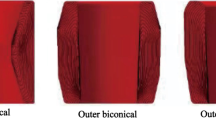Conclusions
The physicomechanical characteristics of the surface layer of steel machine parts after ultrasonic finishing and hardening are superior to those resulting from plastic deformation by static loading or ball burnishing.
Similar content being viewed by others
Literature cited
I. I. Mukhanov, Yu. M. Golubev, et al., Mashinostroitel', No. 9 (1966).
I. I. Mukhanov and Yu. M. Golubev, Vestnik Mashinostroeniya, No. 11 (1966).
I. I. Mukhanov, Vestnik Mashinostroeniya, No. 6 (1968).
I. A. Birger, Residual Stresses [in Russian], Mashgiz, Moscow (1963).
Additional information
Novosibirsk Electrical Engineering Institute. Translated from Metallovedenie i Termicheskaya Obrabotka Metallov, No. 9, pp. 29–32, September, 1969.
Rights and permissions
About this article
Cite this article
Mukhanov, I.I., Golubev, Y.M. The surface layers of steel machine parts after ultrasonic finishing and hardening treatment. Met Sci Heat Treat 11, 701–703 (1969). https://doi.org/10.1007/BF00653162
Issue Date:
DOI: https://doi.org/10.1007/BF00653162




